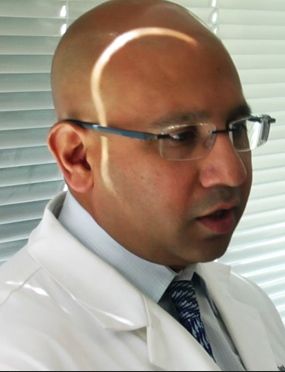07:30 | Morning Coffee, Breakfast Pastries, and Networking |
|
Session Title: Circulating RNA Classes as Potential Biomarkers for Disease |
| |
08:00 | Extracellular RNA Profiles in Central Nervous System Disease
Ashish Yeri, Bioinformatician, The Translational Genomics Research Institute (TGEN), United States of America
The timely diagnosis of neurological disease would help in assessing the risk of developing serious complications permanent brain damage. We are currently investigating the use of extracellular RNA (exRNA) expression in biofluids (plasma, urine and saliva) to serve as biomarkers for a more robust diagnosis of brain injury. ExRNAs, released from all cells in the body are carried within vesicles or bound to RNA-binding proteins in biofluids. Their dynamic expression profile in response to cellular stresses can be coupled with next generation sequencing technologies, allowing for the detection of thousands of RNA at the same time. Here, I present the utility of exRNA biomarkers to diagnose risk for neurological damage such as traumatic brain injuries, subarachnoid hemorrhage, Alzheimer’s, etc. The talk will cover the technologies used in the sequencing of these RNA biomarkers and the analysis methodology for time dependent gene expression data. |
08:30 | Small RNA Biomarkers for Malignant Brain Tumors
Anna Krichevsky, Associate Professor, Brigham and Women’s Hospital and Harvard Medical School, United States of America
The talk will focus on microRNA and other small RNA species released by glioblastoma brain tumors. We will discuss microRNA profiling of cell-free cerebrospinal fluid (CSF) that enables highly sensitive and accurate detection of glioblastoma, discrimination between glioblastoma and metastatic brain tumors, and reflects disease activity. |
09:00 |  | Keynote Presentation Mining for Functional Extracellular RNA Markers of Cardiac Remodeling: The Changing Landscape
Saumya Das, Assistant Professor in Medicine, Beth Israel Deaconess Medical Center and Mass General Hospital, United States of America
Extracellular RNAs (ex-RNAs) have been exploited as biomarkers in many human diseases. We have described the discovery and validation of miRNA-30d as a plasma ex-RNA biomarker that correlates with cardiac remodeling in advanced heart failure, and that appears to play a functional role in cellular processes central to remodeling. In the new era of next-generation sequencing, investigators have attempted to use new discovery and validation platforms to identify novel ex-RNAs as biomarkers in diseases. In this talk, I will described the promise and pitfalls of RNA-sequencing, the challenge of validating RNA-sequencing, and our strategy of prioritizing biomarkers. I will discuss in detail the use of these strategies in the case of post-myocardial infarction remodeling. |
|
09:30 |  | Keynote Presentation OncomiRs as Functional Cancer Biomarkers
Frank Slack, Director, Institute for RNA Medicine, Beth Israel Deaconess Medical Center Cancer Center/Harvard Medical School, United States of America
|
|
10:00 | The Role of Terminal Complement Components in Plasma miRNAs Composition
Ionita Ghiran, Assistant Professor of Medicine, Beth Israel Deaconess Medical Center, United States of America
The complement system is comprised of over 20 soluble and membrane bound proteins with critical roles in recognizing, binding, and removal of foreign particles as well as initiating and regulating innate and acquired immune responses. Activation of the complement system occur during both normal (diurnal) and pathological conditions through any of the classical, alternative, or lectine pathways, that leads to insertion of the membrane attack complex (MAC, C5b-9) pore components in the plasma membrane. The result of MAC-induced exocytosis results in the formation and release in the extracellular space of: a) cytoplasmic components, mostly ions and small molecules, and b) plasma membrane derived vesicles into circulation. This mechanism requires Ca++, calpain activation and local disruption of the actin cytoskeleton. We hypothesized that the size of the C5b-9 complex, about 10 nm, is large enough to allow cellular miRNA species located near the plasma membrane to be released extracellularly.
|
10:30 | Coffee Break and Networking in the Exhibit Hall |
11:00 | Circulating miRNA as a Disease Biomarker
Roopali Gandhi, Assistant Professor in Neurology, Head of MS Biomarkers, Brigham and Women's Hospital/Harvard Medical School, United States of America
A major challenge in MS is to develop immune biomarkers that will allow a better understanding of an individual Multiple Sclerosis patient including response to therapy and disease stage. Stable expression of miRNA in plasma and serum, makes them ideal potential immune biomarker. We found that the expression of miRNAs could be used to differentiate MS patients from control and other neurologic diseases and also to find differences among various clinical groups of MS patients. |
11:30 | microRNA Analysis in Liquid Biopsies
Eveline Emma Vietsch, Research Fellow, Georgetown University, United States of America
Anton Wellstein, Professor, Georgetown University Medical Center, United States of America
Will discuss the background and technical approaches to monitor microRNAs in the circulation. Applications as a potential tool in prognosis of early stage cancers and in treatment responses will be discussed. |
12:00 | Host and Viral Small RNA and microRNA Profiling in Tumor Tissue and Circulation of Patients with Epstein-Barr Virus Driven Nasopharyngeal Carcinoma
Jaap Middeldorp, Professor, Dept. of Pathology, VU University Medical Center Amsterdam, Netherlands
We defined circulating Epstein-Barr virus and host miRNAs in addition to viral DNA load as biomarkers in patients with nasopharyngeal carcinoma and controls and studied the distribution in serum sub-fractions. |
12:30 | Networking Lunch, Discussions with Exhibitors and View Posters |
|
Session Title: Novel Technologies and Approaches for the Study of Circulating Biomarker Classes and Value Capture in the Clinic |
| |
13:30 | 3D microdevice for the in vivo Trapping of Circulating Tumor Cells
Hélène Cayron, PhD student, LAAS-CNRS and Innopsys, France
We propose an intravascular fishnet-like 3D microdevice for the in vivo physical trapping of individual or clustered circulating tumor cells. This device should enable early diagnosis of cancer, repeated and systematic enumeration, recovery and analysis of these cells. |
14:00 | Cell-free DNA Promoter Hypermethylation in plasma as a Biomarker for Pancreatic Adenocarcinoma - Preliminary Results
Stine Dam Henriksen, Researcher, Department of Gastrointestinal Surgery, Aalborg University Hospital, Denmark
DNA promoter hypermethylation is known to be a part of early carcinogenesis. Preliminary results suggest alterations in cell-free DNA promoter hypermethylation to have potential of being markers for pancreatic adenocarcinoma. |
14:30 | Hepatocyte Circulating Mitochondrial DNA Drives Non-alcoholic Steatohepatitis by Activation of TLR9
Wajahat Mehal, Associate Professor, Yale University, United States of America
Nonalcoholic steatohepatitis (NASH) is the most common liver disease in industrialized countries. NASH is a progressive disease that can lead to cirrhosis, cancer, and death, and there are currently no approved therapies. The development of NASH in animal models requires intact TLR9, but how the TLR9 pathway is activated in NASH is not clear. Our objectives in this study were to identify NASH-associated ligands for TLR9, establish the cellular requirement for TLR9, and evaluate the role of obesity-induced changes in TLR9 pathway activation. We demonstrated that plasma from mice and patients with NASH contains high levels of mitochondrial DNA (mtDNA) and intact mitochondria and has the ability to activate TLR9. Most of the plasma mtDNA was contained in microparticles (MPs) of hepatocyte origin, and removal of these MPs from plasma resulted in a substantial decrease in TLR9 activation capacity. In mice, NASH development in response to a high-fat diet required TLR9 on lysozyme-expressing cells, and a clinically applicable TLR9 antagonist blocked the development of NASH when given prophylactically and therapeutically. These data demonstrate that activation of the TLR9 pathway provides a link between the key metabolic and inflammatory phenotypes in NASH. |
15:00 | Sample-Free Detection of Blood Biomarkers via Laser-Treated Skin
Mei Wu, Associate Professor, Mass General Hospital (MGH)/Harvard Medical School, United States of America
The circulatory system is the center for coordination and communication of all organs in our body. Monitoring any changes in its analytes and biomarkers could offer sufficient and timely point-of-care diagnosis. We will present how illumination of a tiny area of the skin with hemoglobin-preferably absorbent laser can increase the amount of circulating biomarkers in the upper dermis by more than 1,000-fold. When specific probe-coated microneedle arrays are applied into the laser-treated skin, the plasma biomarkers accumulated in the upper dermis can be reliably, accurately, and sufficiently captured as early as 15-30 min of the assay in a manner independent of a molecular mass of the biomarkers. The novel, minimally invasive approach may allow engineering small wearable devices for measuring multiple biomarkers simultaneously for point-of-care diagnosis. |
15:30 | Coffee Break and Networking in the Exhibit Hall and Poster Viewing |
16:00 | The Use of Circulating Protein Biomarkers to Identify Mechanisms of Resistance and Restore Sensitivity: The Example of the Bispecific Antibody MM-141 (Istiratumab)
Jason Baum, Director, Companion Diagnostics, Merrimack Pharmaceuticals, United States of America
Understanding why certain patients are insensitive to standard therapies represents a key unmet medical need. By identifying markers of chemo-resistance, we can then look to restore sensitivity using targeted therapies. MM-141 (istiratumab), an investigational bispecific antibody, co-targets IGF-1R and ErbB3; the co-development of a diagnostic test to detect a circulating protein biomarker will be discussed. |
16:30 | Sortilin as a Circulating Biomarker for Cardiovascular Calcification
Elena Aikawa, Associate Professor of Medicine, Brigham and Women’s Hospital, Harvard Medical School, United States of America
Cardiovascular calcification, a growing burden in Westernized countries, is not only a risk factor for cardiovascular events, but may itself contribute to cardiovascular risk. Research into treatment of cardiovascular calcification is lacking, as shown by clinical trials that have failed to demonstrate the reduction of calcific aortic stenosis. Hence the need to elucidate the pathways that contribute to cardiovascular calcification and to develop new therapeutic strategies to prevent or reverse calcification has driven our research investigations. This presentation will discuss studies investigating the novel mechanisms of sortilin in cardiovascular calcification, focusing in particular on its role as a biomarker for abdominal aortic calcification. |
17:00 | Single cell Functional Phenotyping and Phenotypic Drug Profiling in Droplet Microfluidics for Better Targeting of Drug-Resistant Tumors
Tali Konry, Associate Professor, Northeastern University, United States of America
|
18:00 | Close of Day 2 of the Conference |










